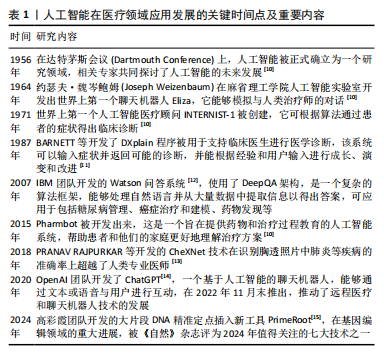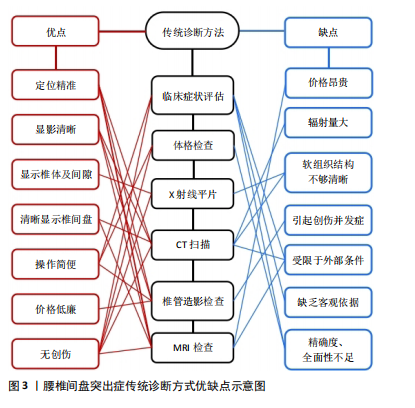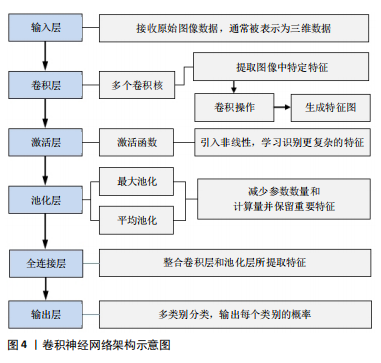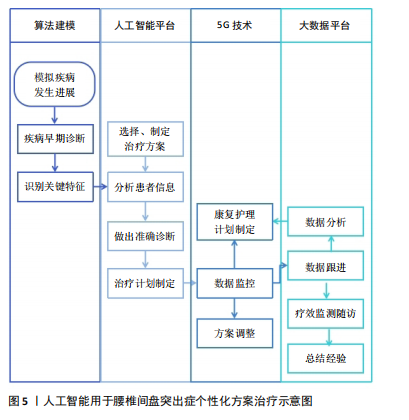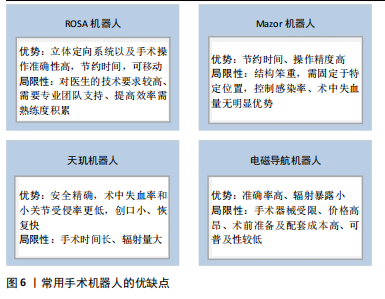[1] 井夫杰,杨永刚.推拿治疗学-全国中医药行业高等教育“十四五”规划教材(供针灸推拿学、康复治疗学等专业用)新世纪第二版[M].北京:中国中医药出版社,2021.
[2] 周莉,吕计宝,蒙珊,等.近5年中医外治疗法治疗腰椎间盘突出症的概述[J].微创医学,2023,18(3):353-356.
[3] BENZAKOUR T, IGOUMENOU V, MAVROGENIS AF, et al. Current concepts for lumbar disc herniation. Int Orthop. 2019;43(4):841-851.
[4] 詹华奎.诊断学基础[M].上海:上海科学技术出版社,2019.
[5] 苏姗姗,石国凤,温丹果,等.中医外治疗法在腰椎间盘突出症患者的应用现状及进展[J].内蒙古中医药,2022,41(11):166-168.
[6] 朱斌,田大胜,陈磊,等.单边双通道内镜技术在腰椎疾病中的应用研究进展[J].中华骨科杂志,2020,40(15):1030-1038.
[7] 顾永才,王斌义.人工智能概论[M].北京:首都经济贸易大学出版社,2020.
[8] 史忠植.人工智能[M].北京:机械工业出版社,2016.
[9] 中国发展研究基金.人工智能在医疗健康领域的应用[M].北京:中国发展出版社, 2021.
[10] HIRANI R, NORUZI K, KHURAM H, et al. Artificial Intelligence and Healthcare: A Journey through History, Present Innovations, and Future Possibilities. Life (Basel). 2024;14(5):557.
[11] ELKIN PL, LIEBOW M, BAUER BA, et al. The introduction of a diagnostic decision support system (DXplain™) into the workflow of a teaching hospital service can decrease the cost of service for diagnostically challenging Diagnostic Related Groups (DRGs). Int J Med Inform. 2010;79(11):772-777.
[12] BOHR A, MEMARZADEH K. The rise of artificial intelligence in healthcare applications. Artificial Intelligence in Healthcare. 2020:25-60. doi:10.1016/B978-0-12-818438-7. 00002-2.
[13] HABIB N, HASAN MM, REZA MM, et al. Ensemble of CheXNet and VGG-19 Feature Extractor with Random Forest Classifier for Pediatric Pneumonia Detection. SN Comput Sci. 2020;1(6):359.
[14] LI J, DADA A, PULADI B, et al. ChatGPT in healthcare: A taxonomy and systematic review. Comput Methods Programs Biomed. 2024;245: 108013.
[15] PAN C, QI Y. PrimeRoot for targeted large DNA insertion in plants. Trends Plant Sci. 2023; 28(8):870-872.
[16] 欧阳汉强,姜亮,刘晓光,等.人工智能在脊柱影像中的应用现状及发展趋势相关研究进展[J].中国脊柱脊髓杂志,2019,29(12):1129-1132.
[17] 许世宏,许世宁.腰椎间盘突出症的四种诊断方法比较[J].山东医药,2005,45(4):78.
[18] 孙成祥,许家铭,章锦.临床、椎管造影及CT检查对腰椎间盘突出症诊断的比较分析[J].颈腰痛杂志,1993(3):4.
[19] 韩立强,江毅,肖联平,等.椎管造影对腰椎退变性疾病的诊断及治疗方法选择的评价分析[J].实用骨科杂志,2011,17(4):340-344.
[20] 姚岗.CT与MRI在腰椎间盘突出症诊断中的价值[J].临床合理用药杂志,2021,14(7):157-158.
[21] 孙伟杰.CT检查在腰椎间盘突出症诊断中的应用价值探讨[J]. 影像研究与医学应用,2024,8(10):123-125.
[22] 肖云敏,张丹瑜,冼少青.CT与MRI在腰椎间盘突出症诊断中的临床价值分析[J].生物医学工程学进展,2018,39(4):212-214.
[23] 梅莉.MRI与CT诊断腰椎间盘突出症的效果分析[J].影像研究与医学应用,2023, 7(21):183-185.
[24] 刘高峰,代志清,王晴晴,等.MRI联合CT检查在腰椎间盘突出症诊断中的应用价值[J].医学影像学杂志,2023,33(7):1316-1318.
[25] 张建,谢会群,提克扎提,等.人工智能在骨科影像学诊断中的应用研究进展[J].中国数字医学,2023,18(4):95-103.
[26] 崔亚轩,胥义,付强.机器学习在脊柱疾病临床诊断中的应用研究进展 [J].小型微型计算机系统,2020,41(11):2449-2457.
[27] ZHANG W, CHEN Z, SU Z, et al. Deep learning-based detection and classification of lumbar disc herniation on magnetic resonance images. JOR Spine. 2023;6(3):e1276.
[28] FAN X, QIAO X, WANG Z, et al. Artificial Intelligence-Based CT Imaging on Diagnosis of Patients with Lumbar Disc Herniation by Scalpel Treatment. Comput Intell Neurosci. 2022;2022:3688630.
[29] WESSELINK EO, ELLIOTT JM, COPPIETERS MW, et al. Convolutional neural networks for the automatic segmentation of lumbar paraspinal muscles in people with low back pain. Sci Rep. 2022;12(1):13485.
[30] HARIBABU M, GURUVIAH V, YOGARAJAH P. Recent Advancements in Multimodal Medical Image Fusion Techniques for Better Diagnosis: An Overview. Curr Med Imaging. 2023;19(7):673-694.
[31] LIU D, WANG S, WANG J. The effect of CT high-resolution imaging diagnosis based on deep residual network on the pathology of bladder cancer classification and staging. Comput Methods Programs Biomed. 2022;215:106635.
[32] APOSTOLOPOULOS ID, PAPATHANASIOU ND, APOSTOLOPOULOS DJ, et al. Applications of Generative Adversarial Networks (GANs) in Positron Emission Tomography (PET) imaging: A review. Eur J Nucl Med Mol Imaging. 2022;49(11):3717-3739.
[33] WANG P, ZHANG Z, XIE Z, et al. Natural Language Processing-Driven Artificial Intelligence Models for the Diagnosis of Lumbar Disc Herniation with L5 and S1 Radiculopathy: A Preliminary Evaluation. World Neurosurg. 2024;189:e300-e309.
[34] JECKLIN S, SHEN Y, GOUT A, et al. Domain adaptation strategies for 3D reconstruction of the lumbar spine using real fluoroscopy data. Med Image Anal. 2024;98:103322.
[35] 王博.低剂量肺部CT的图像增强及其辅助诊断应用研究[D].成都:电子科技大学, 2020.
[36] 蒋正伟.基于深度学习的腰椎间盘突出自动诊断研究[D].青岛:青岛科技大学,2023.
[37] PAN Q, ZHANG K, HE L, et al. Automatically Diagnosing Disk Bulge and Disk Herniation With Lumbar Magnetic Resonance Images by Using Deep Convolutional Neural Networks: Method Development Study. JMIR Med Inform. 2021;9(5):e14755.
[38] 贺泽华.基于卷积神经网络的腰椎间盘突出症诊断研究[D].桂林:桂林电子科技大学,2023.
[39] ZHENG HD, SUN YL, KONG DW, et al. Deep learning-based high-accuracy quantitation for lumbar intervertebral disc degeneration from MRI. Nat Commun. 2022;13(1):841.
[40] AZAM MA, KHAN KB, SALAHUDDIN S, et al. A review on multimodal medical image fusion: Compendious analysis of medical modalities, multimodal databases, fusion techniques and quality metrics. Comput Biol Med. 2022;144:105253.
[41] LI Y, EL HABIB DAHO M, CONZE PH, et al. A review of deep learning-based information fusion techniques for multimodal medical image classification. Comput Biol Med. 2024;177:108635.
[42] STAHLSCHMIDT SR, ULFENBORG B, SYNNERGREN J. Multimodal deep learning for biomedical data fusion: a review. Brief Bioinform. 2022;23(2):bbab569.
[43] WU W, QU J, CAI J, et al. Multiresolution residual deep neural network for improving pelvic CBCT image quality. Med Phys. 2022;49(3):1522-1534.
[44] CHENG J, TIAN S, YU L, et al. ResGANet: Residual group attention network for medical image classification and segmentation. Med Image Anal. 2022;76:102313.
[45] XU W, FU YL, ZHU D. ResNet and its application to medical image processing: Research progress and challenges. Comput Methods Programs Biomed. 2023;240:107660.
[46] VEY BL, GICHOYA JW, PRATER A, et al. The Role of Generative Adversarial Networks in Radiation Reduction and Artifact Correction in Medical Imaging. J Am Coll Radiol. 2019;16(9 Pt B):1273-1278.
[47] SORIN V, BARASH Y, KONEN E, et al. Creating Artificial Images for Radiology Applications Using Generative Adversarial Networks (GANs)-A Systematic Review. Acad Radiol. 2020; 27(8):1175-1185.
[48] CHEN Y, YANG XH, WEI Z, et al. Generative Adversarial Networks in Medical Image augmentation: A review. Comput Biol Med. 2022;144:105382.
[49] MINIC A, JOVANOVIC L, BACANIN N, et al. Applying Recurrent Neural Networks for Anomaly Detection in Electrocardiogram Sensor Data. Sensors (Basel). 2023;23(24):9878.
[50] DVORNEK NC, YANG D, VENTOLA P, et al. Learning Generalizable Recurrent Neural Networks from Small Task-fMRI Datasets. Med Image Comput Comput Assist Interv. 2018;11072:329-337.
[51] BADAHMAN F, ALSOBHI M, ALZAHRANI A, et al. Validating the Accuracy of a Patient-Facing Clinical Decision Support System in Predicting Lumbar Disc Herniation: Diagnostic Accuracy Study. Diagnostics (Basel). 2024;14(17):1870.
[52] KIM HE, COSA-LINAN A, SANTHANAM N, et al. Transfer learning for medical image classification: a literature review. BMC Med Imaging. 2022;22(1):69.
[53] PRISILLA AA, GUO YL, JAN YK, et al. An approach to the diagnosis of lumbar disc herniation using deep learning models. Front Bioeng Biotechnol. 2023;11:1247112.
[54] JIAN J, WANG X, ZHANG J, et al. Molecular landscape for risk prediction and personalized therapeutics of castration-resistant prostate cancer: at a glance. Front Endocrinol (Lausanne). 2024;15:1360430.
[55] BEENA KR. Advancements in AI-driven bioinformatics for oral cancer detection and personalized treatment. Oral Oncology Reports, 2024;10. doi:10.1016/j.oor.2024. 100400.
[56] PAREKH AE, SHAIKH OA, SIMRAN, et al. Artificial intelligence (AI) in personalized medicine: AI-generated personalized therapy regimens based on genetic and medical history: short communication. Ann Med Surg (Lond). 2023;85(11):5831-5833.
[57] KOULAOUZIDIS G, JADCZYK T, IAKOVIDIS DK, et al. Artificial Intelligence in Cardiology-A Narrative Review of Current Status. J Clin Med. 2022;11(13):3910.
[58] MOHSIN SN, GAPIZOV A, EKHATOR C, et al. The Role of Artificial Intelligence in Prediction, Risk Stratification, and Personalized Treatment Planning for Congenital Heart Diseases. Cureus. 2023;15(8): e44374.
[59] 赵晓飞.机器人辅助与徒手腰骶椎椎弓根螺钉置入的精准度及其影响因素分析[D].郑州:河南大学,2020.
[60] BRANDMEIR NJ, SAVALIYA S, ROHATGI P, et al. The comparative accuracy of the ROSA stereotactic robot across a wide range of clinical applications and registration techniques. J Robot Surg. 2018;12(1):157-163.
[61] ZHAO W, WANG Y, ZHANG H, et al. Analysis of the Screw Accuracy and Postoperative Efficacy of Screw Placement in Single Position and Bipedal Position in Robot-Assisted Oblique Lumbar Interbody Fusion: Preliminary Results of Mazor X Stealth Usage. Orthop Surg. 2024;16(2):401-411.
[62] 郑山,王博,韩振川,等.机器人辅助经椎间孔入路脊柱内窥镜手术治疗单节段腰椎椎间盘突出症[J]. 脊柱外科杂志,2023,21(4):224-229.
[63] RAJGOR HD, MAYNE A, MUNASINGHE C, et al. Mako versus ROSA: comparing surgical accuracy in robotic total knee arthroplasty. J Robot Surg. 2024;18(1):33.
[64] MACHETANZ K, GRIMM F, SCHUHMANN M, et al. Time Efficiency in Stereotactic Robot-Assisted Surgery: An Appraisal of the Surgical Procedure and Surgeon’s Learning Curve. Stereotact Funct Neurosurg. 2021;99(1):25-33.
[65] BATAILLER C, HANNOUCHE D, BENAZZO F, et al. Concepts and techniques of a new robotically assisted technique for total knee arthroplasty: the ROSA knee system. Arch Orthop Trauma Surg. 2021; 141(12):2049-2058.
[66] HSU BH, LIU HW, LEE KL, et al. Learning Curve of ROSA ONE Spine System for Transpedicular Screw Placement. Neurospine. 2022;19(2):367-375.
[67] LEE NJ, ZUCKERMAN SL, BUCHANAN IA, et al. Is there a difference between navigated and non-navigated robot cohorts in robot-assisted spine surgery? A multicenter, propensity-matched analysis of 2,800 screws and 372 patients. Spine J. 2021;21(9):1504-1512.
[68] O’CONNOR TE, O’HEHIR MM, KHAN A, et al. Mazor X Stealth Robotic Technology: A Technical Note. World Neurosurg. 2021;145:435-442.
[69] AVRUMOVA F, SIVAGANESAN A, ALLURI RK, et al. Workflow and Efficiency of Robotic-Assisted Navigation in Spine Surgery. HSS J. 2021;17(3):302-307.
[70] MAO G, GIGLIOTTI MJ, MYERS D, et al. Single-Surgeon Direct Comparison of O-arm Neuronavigation versus Mazor X Robotic-Guided Posterior Spinal Instrumentation. World Neurosurg. 2020;137:e278-e285.
[71] 姜超,张永远,王晓晖,等.机器人辅助微创通道下经椎间孔椎间融合术治疗单节段腰椎间盘突出症的临床疗效[J].西安交通大学学报(医学版),2022,43(5):713-719.
[72] LI S, DU J, HUANG Y, et al. Comparison of the efficacies of TINAVI robot-assisted surgery and conventional open surgery for Levine-Edward type IIA (postreduction) hangman fractures. Sci Rep. 2023;13(1):15934.
[73] ZHANG RJ, ZHOU LP, ZHANG L, et al. Safety and risk factors of TINAVI robot-assisted percutaneous pedicle screw placement in spinal surgery. J Orthop Surg Res. 2022;17(1): 379.
[74] LI S, DU J, HUANG Y, et al. Comparison of surgical efficacy between O-arm combined with CT 3D real-time navigation system and Tinavi robot-assisted treatment of adolescent congenital scoliosis. Am J Transl Res. 2023;15(5):3254-3266.
[75] 石运永,林力,吴文波.采用电磁导航技术的手术机器人应用研究[J].中国医疗器械杂志,2023,47(1):26-31.
[76] 林涌鹏,李永津,陈博来,等.电磁导航与C臂透视引导经皮椎间孔镜手术治疗腰椎间盘突出症的疗效比较:2年随访[J].实用医学杂志,2021,37(21):2733-2738.
[77] 王少纯,陈波涛,李黔春.电磁导航辅助经椎间孔脊柱内窥镜系统治疗腰椎椎间盘突出症[J].脊柱外科杂志,2020,18(6):386-391.
[78] SAGI HC, MANOS R, BENZ R, et al. Electromagnetic field-based image-guided spine surgery part one: results of a cadaveric study evaluating lumbar pedicle screw placement. Spine (Phila Pa 1976). 2003;28(17):2013-2018.
[79] WU B, WEI T, YAO Z, et al. A real-time 3D electromagnetic navigation system for percutaneous transforaminal endoscopic discectomy in patients with lumbar disc herniation: a retrospective study. BMC Musculoskelet Disord. 2022;23(1):57.
[80] MOUSTRIS G, TZAFESTAS C, KONSTANTINIDIS K. A long distance telesurgical demonstration on robotic surgery phantoms over 5G. Int J Comput Assist Radiol Surg. 2023;18(9):1577-1587.
[81] TIAN W, FAN M, ZENG C, et al. Telerobotic Spinal Surgery Based on 5G Network: The First 12 Cases. Neurospine. 2020;17(1):114-120.
[82] 翁艳.腰椎间盘突出症临床病例数据库的建立及应用[D].成都:四川大学,2021.
[83] 车晋强.基于Spark平台的高血压药物推荐及疗效预测研究[D].太原:太原理工大学,2016.
[84] 张玢,门佩璇,肖宇锋,等.大数据分析在骨科的应用研究进展[J].中华骨与关节外科杂志,2021,14 (10):866-871.
[85] 韩杰,温帅波,徐志为,等.基于数据挖掘探讨国医大师韦贵康治疗腰椎间盘突出症的用药规律[J]. 西部中医药,2024,37(5):66-71.
[86] OSTERMAN H, SEITSALO S, KARPPINEN J, et al. Effectiveness of microdiscectomy for lumbar disc herniation: a randomized controlled trial with 2 years of follow-up. Spine (Phila Pa 1976). 2006;31(21):2409-2414.
[87] 叶青青.基于数据包络分析(DEA)的气滞血瘀型腰痛病中医综合治疗方案疗效评估[D].成都:成都中医药大学,2020.
[88] SHAMIM MS, ENAM SA, QIDWAI U. Fuzzy Logic in neurosurgery: predicting poor outcomes after lumbar disk surgery in 501 consecutive patients. Surg Neurol. 2009; 72(6):565-572; discussion 572.
[89] WIRRIES A, GEIGER F, HAMMAD A, et al. Artificial intelligence facilitates decision-making in the treatment of lumbar disc herniations. Eur Spine J. 2021;30(8):2176-2184.
[90] WIRRIES A, GEIGER F, HAMMAD A, et al. AI Prediction of Neuropathic Pain after Lumbar Disc Herniation—Machine Learning Reveals Influencing Factors. Biomedicines. 2022;10:1319.
[91] 左涌丽,符碧峰,郭圣璇,等.脉冲射频术治疗中老年腰椎间盘突出症患者中长期临床疗效的列线图预测模型构建[J/OL].颈腰痛杂志,1-14[2024-11-15].http://kns.cnki.net/kcms/detail/34.1117.R.20240529.1553.004.html.
[92] 梁啸,李东儒,陈筱,等.内镜腰椎间盘切除术后复发的因素及预测模型[J].中国矫形外科杂志,2024,32(9):775-780.
[93] 李晓红,陈娟娟.腰椎间盘突出症病人术后发生恐动症的影响因素[J].循证护理, 2024,10(14):2610-2615.
[94] KIM JH, LEE SE, JUNG HS, et al. Development and Validation of Deep Learning-Based Algorithms for Predicting Lumbar Herniated Nucleus Pulposus Using Lumbar X-rays. J Pers Med. 2022;12(5):767.
[95] 姚红艳,邓兴,陈晓飞,等.腰椎X线摄影人工智能测量技术研究进展[J].中国医学物理学杂志,2021,38(12):1579-1584.
[96] 黄鸣宇,吴丽梅,邝晓东,等.CT图像增强辅助诊断系统在椎间盘突出诊断中的应用研究[J].中国医学装备,2020,17(12):44-48.
[97] 翟禹樵,李开南.骨科人工智能诊断的研究进展[J].中国临床研究,2021,34(4):542-545.
[98] MEJIA MR, ARROYAVE JS, SATURNO M, et al. Use of ChatGPT for Determining Clinical and Surgical Treatment of Lumbar Disc Herniation With Radiculopathy: A North American Spine Society Guideline Comparison. Neurospine. 2024;21(1):149-158.
[99] KAYASTHA A, LAKSHMANAN K, VALENTINE MJ, et al. Lumbar disc herniation with radiculopathy: a comparison of NASS guidelines and ChatGPT. N Am Spine Soc J. 2024; 19:100333.
[100] DUAN X, XIONG H, LIU R, et al. Enhanced deep leaning model for detection and grading of lumbar disc herniation from MRI. Med Biol Eng Comput. 2024. doi:10.1007/s11517-024-03161-5.
[101] Wang P, Zhang Z, Xie Z, et al. Natural Language Processing-Driven Artificial Intelligence Models for the Diagnosis of Lumbar Disc Herniation with L5 and S1 Radiculopathy: A Preliminary Evaluation. World Neurosurg. 2024;189:e300-e309.
|
